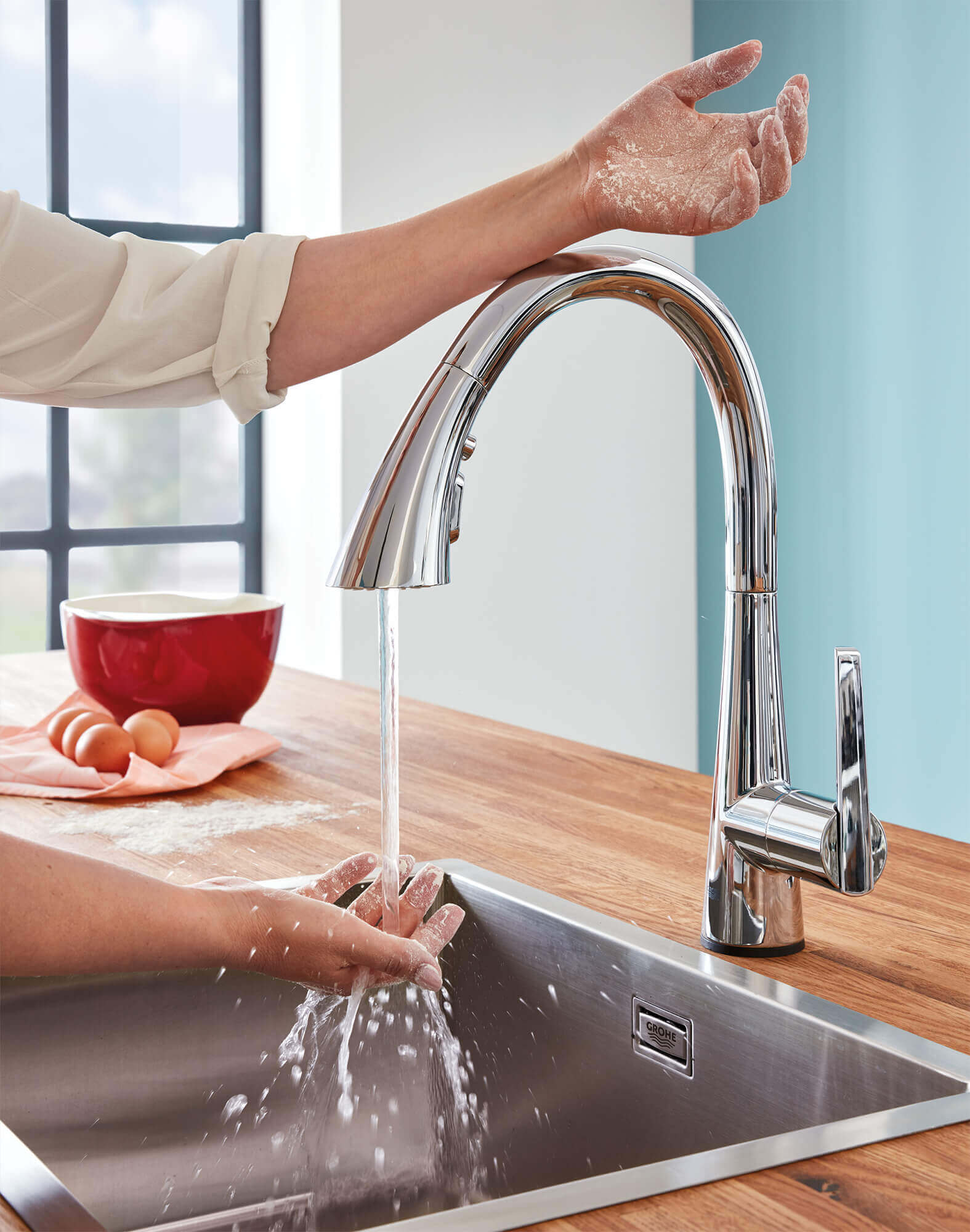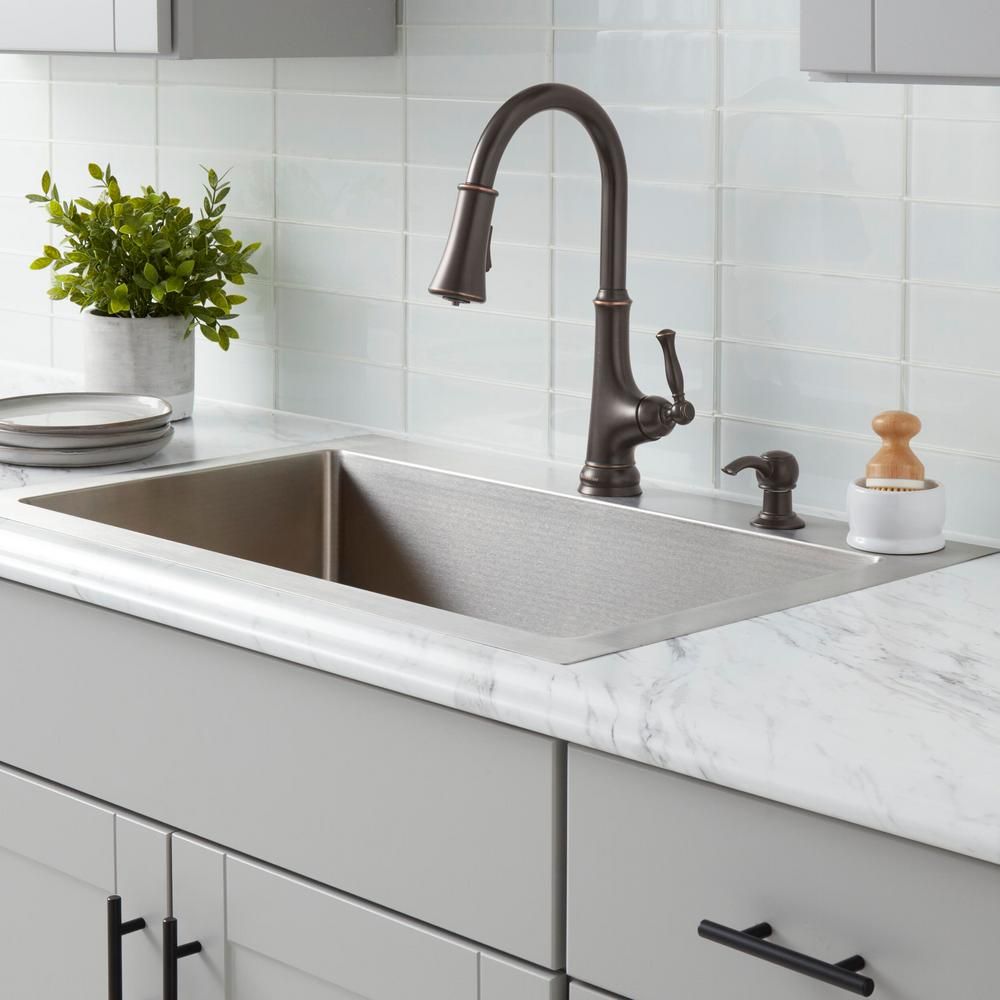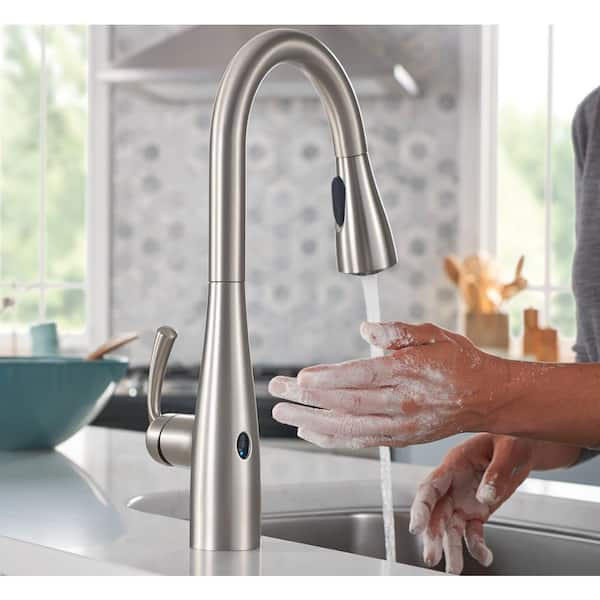Kitchen faucet technology has evolved significantly in recent years, with hands-free faucets emerging as one of the most innovative and convenient options available today. These faucets offer a range of benefits that make them an increasingly popular choice for both residential and commercial kitchens. One of the primary advantages of hands-free kitchen faucets is their ability to promote better hygiene. Since these faucets can be operated without touching them, they reduce the spread of germs and bacteria, which is particularly important in environments where food is prepared. This touchless operation is made possible by motion sensors or touch-sensitive technology, which detects the presence of a hand or object near the faucet and automatically activates the water flow.
Hands-free kitchen faucets also contribute to water conservation. Traditional faucets often lead to unnecessary water wastage, either due to being left on for too long or because of the difficulty in turning them off with soapy or greasy hands. With hands-free faucets, water flow is automatically turned off when it’s no longer needed, which can significantly reduce water consumption. This feature is not only beneficial for the environment but can also lead to lower utility bills, making it a cost-effective choice in the long run. Furthermore, these faucets are often equipped with adjustable flow rates and temperature controls, allowing users to customize their water usage according to their specific needs.

The convenience factor of hands-free kitchen faucets cannot be overstated. In a busy kitchen environment, having the ability to operate the faucet without using hands can be a real time-saver. For instance, when hands are full or dirty, simply waving a hand or placing an object near the sensor can activate the faucet, allowing for quick and easy access to water. This convenience extends to the cleanup process as well, as users can easily rinse dishes or wash their hands without having to fumble with faucet handles. Additionally, many hands-free faucets are designed with user-friendly interfaces, making them easy to operate for people of all ages and abilities.
Another key benefit of hands-free kitchen faucets is their contribution to a cleaner kitchen environment. Traditional faucets can become breeding grounds for germs and bacteria, especially when frequently touched with dirty hands. Hands-free faucets eliminate this problem by minimizing the need for physical contact, thereby reducing the risk of cross-contamination. This is particularly important in homes with young children or individuals with compromised immune systems. Moreover, the sleek and modern design of many hands-free faucets makes them easy to clean and maintain, further contributing to a more hygienic kitchen.

The technology behind hands-free kitchen faucets is continually advancing, with many models now featuring smart capabilities. These smart faucets can be integrated with home automation systems, allowing users to control the faucet remotely via smartphone apps or voice commands. For example, some smart faucets can be programmed to dispense a specific amount of water at a certain temperature, which can be particularly useful for tasks like filling a pot or preparing baby formula. This level of control not only enhances convenience but also ensures precise water usage, further contributing to water conservation efforts.
Hands-free kitchen faucets are available in a variety of styles and finishes, making it easy to find a model that complements the overall design of your kitchen. Whether you prefer a sleek, modern look or a more traditional aesthetic, there is likely a hands-free faucet that will meet your needs. Many of these faucets are also designed with high-quality materials, ensuring durability and longevity. This means that, in addition to their functional benefits, hands-free faucets can also add value to your home by enhancing its overall appearance and functionality.

Installation of hands-free kitchen faucets is generally straightforward, although it may require some basic plumbing knowledge. Many models come with detailed instructions and all the necessary hardware, making it possible for homeowners to install them without the need for professional assistance. However, it’s important to ensure that the faucet is compatible with your existing sink and plumbing setup before making a purchase. Additionally, some hands-free faucets require a power source, either in the form of batteries or an electrical connection, so it’s important to consider this when planning the installation.
In terms of maintenance, hands-free kitchen faucets are relatively easy to care for. Since there are fewer physical components to wear out or become damaged, these faucets tend to have a longer lifespan compared to traditional models. Regular cleaning of the sensor and faucet body is usually sufficient to keep it functioning properly. However, it’s important to be aware of potential issues that can arise, such as sensor malfunctions or battery depletion in models that rely on battery power. Most manufacturers provide troubleshooting guides and customer support to assist with any problems that may occur.
The adoption of hands-free kitchen faucets is also driven by the growing trend toward smart home technology. As more households embrace connected devices and automation, hands-free faucets are becoming an integral part of modern kitchens. These faucets not only offer practical benefits but also align with the broader movement toward creating more efficient, sustainable, and convenient living spaces. For those looking to upgrade their kitchen, a hands-free faucet can be a worthwhile investment that enhances both functionality and aesthetics.
Despite their many advantages, hands-free kitchen faucets do come with some potential drawbacks. For instance, the initial cost of these faucets can be higher than that of traditional models, which may be a consideration for budget-conscious consumers. Additionally, while most sensors are designed to be highly responsive, there can be occasional issues with sensitivity, such as the faucet activating unintentionally or not responding when needed. It’s also worth noting that the reliance on technology means that these faucets are more prone to technical issues compared to their manual counterparts.

When choosing a hands-free kitchen faucet, it’s important to consider factors such as sensor type, power source, and additional features. Some models use infrared sensors, while others rely on capacitive touch technology. Each type has its own advantages and limitations, so it’s important to choose a model that best suits your needs. Additionally, consider whether you prefer a battery-operated faucet or one that connects to your home’s electrical system. Battery-operated models offer greater flexibility in terms of installation, but they require regular battery replacements, while electrically powered faucets provide consistent performance but may require professional installation.
Another consideration is the faucet’s compatibility with your existing kitchen setup. Ensure that the faucet’s dimensions, spout height, and reach are suitable for your sink. Some hands-free faucets are designed for single-hole installation, while others may require additional holes for features like a side sprayer or soap dispenser. It’s also important to check whether the faucet’s finish matches the other fixtures in your kitchen. Popular finishes include chrome, stainless steel, and matte black, each offering different levels of durability and aesthetic appeal.
One of the most attractive features of hands-free kitchen faucets is the wide range of additional functionalities they offer. For example, some models come with a pull-down or pull-out spray head, which provides greater flexibility for tasks like rinsing dishes or cleaning the sink. Others may feature adjustable water flow rates, allowing you to switch between a steady stream and a more powerful spray. Some high-end models even offer temperature memory, which allows the faucet to automatically return to the last used water temperature, providing added convenience.
In addition to residential use, hands-free kitchen faucets are also becoming increasingly popular in commercial settings. Restaurants, cafes, and other food service establishments can benefit greatly from the hygienic and water-saving features of these faucets. In such environments, where sanitation is of utmost importance, hands-free faucets can help reduce the risk of cross-contamination and improve overall cleanliness. Moreover, the time-saving benefits of these faucets can contribute to more efficient kitchen operations, allowing staff to focus on other important tasks.

Common Mistakes To Avoid
As with any technological advancement, there are common mistakes that users and buyers might make when dealing with hands-free kitchen faucets. One frequent error is choosing a faucet based solely on its appearance without considering functionality or compatibility with the existing kitchen setup. This can lead to issues such as improper installation, insufficient water pressure, or an inconvenient spout height. It’s essential to thoroughly assess both the practical and aesthetic aspects of the faucet to ensure it meets all your needs.
Another common mistake is neglecting the power source requirements. Some users may overlook the need for batteries or an electrical connection, leading to frustration when the faucet doesn’t operate as expected. It’s important to be aware of the power requirements before purchase and to have a plan for how to accommodate them, whether that means ensuring easy access for battery changes or arranging for an electrical outlet near the sink. Additionally, improper maintenance of the sensor can lead to malfunctions, so regular cleaning and checking for obstructions are crucial for optimal performance.
Failing to consider the long-term maintenance needs is another mistake that can diminish the enjoyment of a hands-free faucet. While these faucets are generally low-maintenance, they do require some care to keep them functioning smoothly. Ignoring regular maintenance tasks, such as cleaning the sensor and checking the power source, can lead to performance issues over time. Understanding the maintenance requirements and following the manufacturer’s guidelines can help ensure that your faucet remains in good working condition for years to come.
Finally, some users may be tempted to purchase a cheaper, low-quality hands-free faucet to save money. However, opting for a lower-priced model often means sacrificing durability, reliability, and advanced features. Investing in a reputable brand with a strong warranty and customer support can save money and frustration in the long run. A higher-quality faucet is more likely to provide consistent performance and last longer, making it a better value over time.

How does a hands-free kitchen faucet work?
A hands-free kitchen faucet operates using motion sensors or touch-sensitive technology to detect when to turn the water on and off. When a hand or object is placed near the sensor, it activates the faucet, allowing water to flow without physically touching the faucet handles. This touchless operation is especially beneficial for maintaining hygiene and convenience in the kitchen, as it reduces the spread of germs and makes it easier to access water when your hands are full or dirty.
Are hands-free kitchen faucets difficult to install?
While the installation of hands-free kitchen faucets is generally straightforward, it does require some basic plumbing knowledge. Most models come with detailed instructions and the necessary hardware, making it possible for many homeowners to install the faucet themselves. However, it’s important to ensure that the faucet is compatible with your sink and plumbing setup. Some models also require a power source, such as batteries or an electrical connection, which should be considered during installation planning.
What are the common issues with hands-free kitchen faucets?
Common issues with hands-free kitchen faucets can include sensor malfunctions, such as the faucet not activating when needed or turning on unintentionally. Battery-operated models may experience issues with battery depletion, while electrically powered faucets may have problems related to the power supply. Regular maintenance, such as cleaning the sensor and checking the power source, can help prevent and address these issues. Most manufacturers provide troubleshooting guides and customer support to assist with any problems.
How do I choose the right hands-free kitchen faucet for my home?
When choosing a hands-free kitchen faucet, consider factors such as the sensor type, power source, and additional features. Infrared sensors and capacitive touch technology are two common types, each with its advantages. Decide whether you prefer a battery-operated model or one that connects to your home’s electrical system. Also, ensure that the faucet’s dimensions, spout height, and finish match your kitchen setup and aesthetic preferences. Reviewing product reviews and manufacturer warranties can also help you make an informed decision.
Can hands-free kitchen faucets help save water?
Yes, hands-free kitchen faucets are designed to promote water conservation by automatically turning off the water flow when it’s no longer needed. This reduces water wastage that often occurs with traditional faucets, where water may be left running longer than necessary. Many hands-free faucets also feature adjustable flow rates and temperature controls, allowing users to customize their water usage and further contribute to conservation efforts.
Are hands-free kitchen faucets more expensive than traditional faucets?
Generally, hands-free kitchen faucets can be more expensive than traditional models due to their advanced technology and features. However, the initial higher cost can be offset by the benefits they offer, such as improved hygiene, water conservation, and convenience. Additionally, investing in a high-quality, durable faucet can provide long-term savings by reducing maintenance needs and lowering utility bills.

Related Posts:
- Double Kitchen Sink With Faucet
- Moen Kitchen Faucet Leaking From Hose
- Delta Lakeview Single Handle Pull Down Sprayer Kitchen Faucet
- Best Low Profile Kitchen Faucet
- How To Install Kitchen Faucet On Granite Countertop
- Beale Pull Down Kitchen Faucet With Selectronic Hands Free Technology
- Cleanflo Andromeda White 1 Handle Pull Out Kitchen Faucet
- Delta Touchless Kitchen Faucet Not Working
- Black Farmhouse Kitchen Faucet
- Brass Wall Mount Kitchen Faucet